




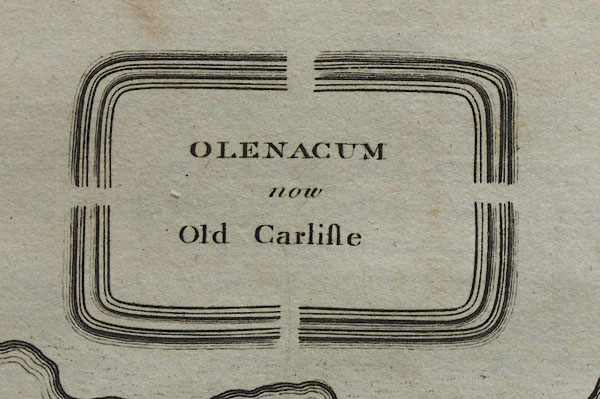
BOX01.jpg From Hutchinson 1794 map 2.
"OLENACUM now Old Carlisle"
"Remains of ROMAN STATION"
placename:- Old Carlile
placename:- Castra Exploratorum
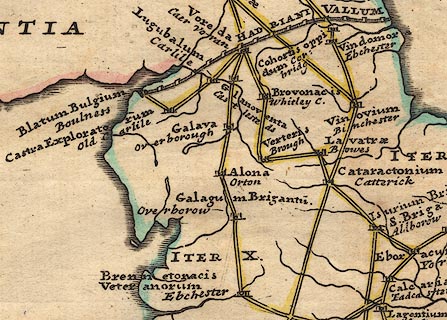 click to enlarge
click to enlargeStu1Cm.jpg
item:- Hampshire Museums : FA2001.171
Image © see bottom of page
item:- roman altar
 goto source
goto sourceGentleman's Magazine 1755 opp p.360
 click to enlarge
click to enlargeG755E01.jpg
item:- inscription, roman; roman inscription
 goto source
goto sourceGentleman's Magazine 1755 p.360 "Mr URBAN,"
"AS you have often obliged the public with accounts of British and Roman antiquities, which have been discovered in various parts of this island, I send you the best drawing I could make of two Roman altars and a trough, which were very lately found by some workmen as they were digging for the foundation of a ring wall against the common at old Carlisle, about 200 yards east of a Roman legionary garrison. The Agger's praetorium, ditches, and roads belonging to this station are still to be traced by their remains on this uncultivated common, and the Alae Auxiliariae appears by many scattered ruins to have encamped eastward a long way."
"Some doubt has been made what was the antient name of this place. Mr Cambden gives it no name, though he calls it a famous city: It is indeed most probable that he never saw it, for there are no remains of building besides the fort, of which the wall is here and there still to be seen, and some wretched huts, which seem to have been cobbled up by private soldiers, merely to shelter them from the weather, for the remains of them are of very bad stone, though there is a good quarry at a little distance, to which recourse would certainly have been had if any regular edifices had been raised for more durable purposes, many of which there must have been to constitute a city."
"Dr Stukeley supposes it have been the Castra Exploratorum, but this also is a very improbable conjecture, for it cannot be thought that Antonine would have begun his itinerary for London here, and computed 12 stadia to Bowness, 12 to Carlisle, and 20 to Penrith, and so on, because this rout, as is plain from the map, is far from being the shortest way, which the Romans, who were eminent for accuracy and expedition, always took."
"Mr Horsley, with much greater appearance of truth, supposes this place to be the antient Olenacum, and to be garrisoned by the Alae Herculeana. This question, however, would probably be ascertained, if the remainder of the stone, Fig. I. can be found, for which I have directed diligent search to be made, because on this fragment will be seen the name of the cohort which should immediately precede the words cui praeest."
"The date of this stone is ascertained, as it is said to be consecrated by one AElius Septimianus Rusticus, a praefect in the consulship of Maternus and Bradua."
"The other stone, Fig. II. is also incompleat, but this seems to have been mutilated at the side by the Romans themselves, for there are marks of their pick all over it. It is dedicated to the health of Septimus Severus, the great triumpher over Britain, and builder of the stone wall, the ruins of which 1500 years have not mouldered away."
"Fig. III. is a trough to the use of which I confess myself wholly a stranger, and should be glad to see the conjectures of some of your ingenious correspondents on the subject."
"The altars, Fig. I. and II. are about two feet high, and 15 inches thick; there is no fire place on the top of them, nor any sacrificial vessels on the sides, yet the workmanship is not contemptible. The trough is 22 inches long, 14 wide, and six deep; the rim is about 4 inches and an half; the letters are about 3 inches, very legible, none of them being defaced."
"The inscriptions I read thus:"
"Fig. I. Cui praeest AElius Septimianus Rusticus praefectus Materno et Bradua Consulibus."
"Fig. II. Jovi Optimo maximo pro Salute Imperatoris Septimi Severi Marcus Aurelius Antoninus."
 goto source
goto sourceGentleman's Magazine 1755 p.361 "If the other fragments are found, they shall be communicated by"
"Sir, yours, &c G.S."
"P.S. There is an high Roman road, which has never yet been taken notice of, leading in a streight line from Plumpton fort to Ellenborough; the stations upon it are four, Plumpton fort, Cast Steeds on Broadfield, Old Carlisle near Wigton, and Ellenborough; their names I conjecture to have been Voreda, Brementuracum, Olenacum, and Virosidum. There is also a streight Roman road from Virosidum by Abbey-holm to Carlisle."
placename:- Castra Exploratorum
item:- roman altar
 goto source
goto sourceGentleman's Magazine 1756 opp p.431
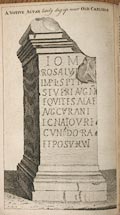 click to enlarge
click to enlargeG756E01.jpg
item:- inscription, roman; roman inscription; roman altar
 goto source
goto sourceGentleman's Magazine 1756 p.431 "Mr URBAN, Wigton, July 16, 1756."
"THE INCLOSED (see the plate) is an exact copy of the inscription on a votive altar, and a draught of the stone, which was lately dug up near Old Carlisle, as it is called by the neighbouring inhabitants."
"Antoninus fixes the Castra Exploratorum some where near this place: indeed the situation of these antient ruins renders the name very proper; for the station has been on a hill, which commands a free prospect of the country, and therefore extremely convenient for spying an enemy."
"This stone was found a few yards distant from the place where the two fragments of the altars were dug up, whose inscriptions were copied by the late Mr Smith, in your Magazine. (See Altar Gen. Index to the first 20 volumes."
"Yours, &c. T. TOMLINSON."
Notice the reference to George Smith.
 goto source
goto sourceGentleman's Magazine 1757 opp p.220
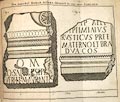 click to enlarge
click to enlargeG757E01.jpg
"Two imperfect ROMAN ALTARS, discovered in 1755, near CARLISLE"
item:- inscription, roman; roman inscription; roman altar
 goto source
goto sourceGentleman's Magazine 1757 p.220 "Mr URBAN, Wigton, April 8."
"ENclosed I have sent you an exact draught of the two imperfect altars which were dug up near Carlisle in 1755. As the workmanship, notwithstanding their present mutilated condition, is far from being contemptible; and as the prints you gave us of them in your Magazine for August 1755, were not such just copies of the originals, nor the inscriptions so correct as I could have wished to have seen them, these, I thought, might not be unacceptable to the curious."
"Fig. I. This inscription is sadly defaced, and there is something uncommon in the shape of the letters, especially the A s and M s. But, were it not differing from better judgment, I should be for reading it thus:"
"(Jovi) Optimo maximo / Pro Salute L. Septimii / Severi et (or item) Mar. Aur. Antonini."
"The other (Fig II.) as far as perfect, is legible enough; and the reading in your Mag. I take to be the true one; though the imperfect letter in the second line, which ought to be S, to make the Septiminus, seems rather to be the tail of an J."
"Yours, &c. T. T."
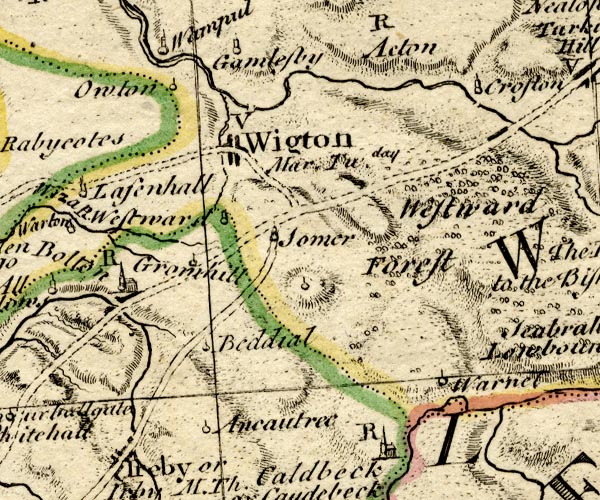
BO18NY24.jpg
circle, tower, in a ring of hachuring
item:- Armitt Library : 2008.14.10
Image © see bottom of page
placename:- Old Carlisle
placename:- Olenacum
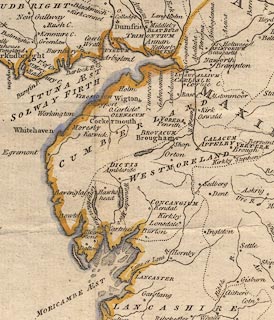 click to enlarge
click to enlargePEN1Cm.jpg
"O. Carlisle / OLENACUM"
circle; buildings, village, etc
item:- private collection : 66
Image © see bottom of page
placename:- Olenacum
item:- roman inscription; inscription, roman; roman altar; altar, roman
 goto source
goto sourcePage 186:- "..."
"The Ala Augusta continued at Old Carlisle, as we learn from inscriptions from A.D. 188 to A.D. 242. The Notitia at Olenacum seems to call it Ala Herculea. A military way has gone from the wall southward from Old Carlisle to Elenborough. The ruins of the Roman town and station are very grand and conspicuous on a large and visible military way leading directly to Carlisle and the wall, and there is no other station on the wall between it and Carlisle. There seems to have been a double rampart round it. The river Wiza runs about half a mile from the south and west side, and from the west is a fine prospect to the sea. The first of Mr. Camden;'s inscriptions is now in the west wall of the garden at Drumburgh. Mr. Gale in Phil. Trans. No.357, reads the first word of the 5th line LING. N. quasi Lingonensis for the name of the province or place whence Tiberius or Justinus came. Another found here belonging to the same ala has been mentioned at Elenborough, and is Horsley's lvii. The next may have been on a defaced altar in the hayloft at Drumburgh. The third was brought away by sir Robert Cotton to Connington, and is now at Trinity college Cambridge. The letters rude and uneven. The Ala is here called Gordiana, the date A.D. 242, under the reign of Gordian III. The altars at Wigton are probably gone. The milliary was in Horsley's time at Naworth castle, now at Rookby. The other two are now lost, but the second of them may be a dedication to Ocean, as Ward, or to Mars, and Mercury, and the next two may be effaced from two altars now at Drumburgh. The other articles mentioned by Mr. Camden I take to be Lares."
"Another inscription on an altar by the ala Augusta found here 1756 is copied from Gent. Mag. Sept. 1756, and is to be thus read:"
"Jovi optimo maximo
pro salute
Imperatoris Lucii Septimi
Severi Augusti nostri
Equites alae
Augustae curante
Egnatio Vere-
cundo prae-
secto posuerunt."
"Two more inscriptions found here are copied from Gent. Mag. May 1757. XXVII. p.220."
"Old Carlisle is in the parish of Westward."
placename:- Old Carlisle
placename:- Castra Exploratum
item:- roman inscription; inscription, roman; roman altar; altar, roman
 goto source
goto sourcePage 172:- "..."
"... the Wiza another little stream, at whose source the poor remains of an antient city stand as monuments that nothing in this world is exempt from the lot of mortality. This is now called by the inhabitants Old Carlisle: what was its antient name I know not, unless it was CASTRA EXPLORATUM, The distance in Antoninus (who does not take the shortest way, but recites the more considerable places), agrees both from Bulgium and Luguvallum. The situation was very convenient for discovering an enemy; for it stands on a hill of considerable height, affording a good view of the country all round. Certain it is, that the wing, which, for its valor, was called AUGUSTA and AUGUSTA GORDIANA was here in the time of Gordian, from the following inscriptions which I saw in the neighbourhood of this place at Ilkirk:"
"[*] I. O. M.
ALA. AVG. OB
[*]... RTVT. APPEL. CVI
PRAEEST. TIB. CL. TIB.F.P. [*]
[*] IN... G... N JVSTINVS
PRAEF. FVSCIANO
II. SILANO II COS"
"D. M.
MABLI
NIVS SEC
VNDVS
EQVIS
ALE AVG
STE STIP."
"I.O.M.
PRO SALVTE IMPERATORIS
M. ANTONI GORDIANI. P. F.
INVICTI AVG ET SABINAE TR [*]
IAE TRANQVILE CONIVGI EIVS TO
TAQVE DOMV DIVIN. EORVM A-
LA AVG. GORDIA. OB VIRTVTEM
APPELLATA POSVIT: CVI PRAEEST
AEMILIVS CRISPINVS PRAEF.
EQQ. NATVS IN PRO AFRICA DE
[*] TVIDRO SVB CVR NONNII PH
LIPPI LEG. AVG. PROPRETO...
ATTICO ET PRETEXTATO
COSS"
"From hence were brought the altars that stand by the road side at Wigton, having on their sides a simpulum, a futile, a mallet, a patera, and other instruments of sacrifice: but the letters are entirely worn out by time. Not far from hence was dug up by the military way a pillar of rough stone, now at Thoresby, with the inscription:"
"IMP CAES
M. IVL.
PHILIPPO
PIO FELI
CI
AVG
ET M. IVL. PHI
LIPPO NOBILIS
SIMO CAES
TR. P. COS..."
"This was likewise copied for me by that most learned minister Oswald Dikes, now preserved in his brother T. Dike's house at Wardal."
"DEO
SANCTO BELA
TVCADRO
AVRELIVS
DIATOVA [*] ARAE
X VOTO POSVIT
LL.MM."
"Another similar isncription in honour of a topical deity has also been found:"
"DEO
CEAIIO AVR
MRTI ET MS
ERVRACIO PRO
SE ET SVIS. V. S.
LL. M."
"besides great numbers of small images, statues on horses, eagles, lions, Ganimedes, and many other evidences of antiquity continually coming to light."
item:- inscription, roman; roman inscription
 goto source
goto sourceGentleman's Magazine 1843 part 1 p.35 "Heavitree, Dec. 5."
"MR. URBAN,"
"I BEG to correct the interpretation of the first and second lines of the Inscription noted in your Magazine for this month. The Rev. R. Matthews will not err in altering it to I . O . M . (JOVI OPTIMO MAXIMO) ET . VOLKANO (VLK contraction): To the most benficient and almighty Jupiter and Vulcan, who was the son of Jove."
"The "Deo Volkano" occurs on some of the coins of P. Lic. Valerianus, brother to Gallienus; and Mr. Akerman gives a silver one of his, DEO . VOLKOAN. rev. Statue of Vulcan within a temple. (Descr. Cat. vol.ii p.14.)"
"Valerian erected a temple to Vulcan, as his brother did to Mars; from his skill in fabricating armour, he was as needful to war as any other deity - perhaps more so: had the Emperor Julian not forgotten to put on his cuirass, he would not have fallen by the Persian lance, by the same mishap which terminated the career of the immortal Sir P. Sidney, near Zutphen, namely, omitting to buckle on his cuishes, or thigh-armour."
"It is not suprising, therefore, that the Augustan band or cohort should dedicate their votive altar to the great MULCIBER as well as to Jove - viz. "Pro Salute," for the health and safety of Valerian - to what little purpose his unfortunate exit will bear testimony; but armour of proof would be the best guarantee, of course, for how could he enjoy health, or be in safety if incurring the peril of wounds, without the aid of Vulcan, who presided over the fabrication of armour?"
"An inscription occurs"
"I . O . M . ET . GENIO . P . R . ET . VENALIC ."
"which proves it was usual to couple the omnipotent Jove with other members of the heirarchy of the times."
"The Augustan cohort of the days of Gordian the Third must have been of the same rank and routine of service as the Cohors Praetoria, which was especially attached to the body-guard of the Praetor of the province where it was stationed."
"The latter was also composed of horse and foot, and of what, in modern warfare, were denominated reformadoes or chosen men, similar to the "Cuneus Armaturarum," at Brementeracum (Brampton, Cumberland), who were, properly speaking, "Milites in Comitatu Imperatoris," belonging to the Emperor's train or body-guard, and not "a body of troops in armour," as some writers have designated armatura, which is found in Ammianus, and was composed of cavalry."
"Yours, &c."
"W. T. P. SHORTT."
"P.S. I shall be glad to hear of any discoveries relating to the ALA HER"
"[HER]CULEA of the Notitia, stationed at Olenacum in the latter days of the empire."
 goto source
goto sourceGentleman's Magazine 1842 part 2 p.599 "[be]came synonymous. I read the inscription thus:-"
"I.O.M. ET VLK.
Pro salute Domini Nostri Marci Antonini Gordiani
Pii Felicis, Augusti septimum, magnam Aram
Cohors prima Augusta dedit."
"If I read the last line correctly, this is the only Inscription recorded to have been found at Old Carlisle which make mention of a Cohort, and which in doing so distinctly informs us of what before was merely a matter of conjecture, - that the Ala Augusta was a military body composed of horse and foot. And this, it appears to me, is the only new historical information that can be gathered from it."
"After an attentive examination of the original, I am of opinion, that No.6, in your list of Inscriptions found at Old Carlisle, cannot be read otherwise than thus:-"
"I.O.M
Pro salute domini nostri Marci Antonini pii felicis Agusti - (Rufus Colegius cui Praefectus est) - Ala Agusta - Quartum Imperatore Antonino et Balbino secundum Consulibus."
"The peculiarities of this Inscription are - Cui Praefectus est, instead of Cu Praest, and Quartum before the name of the Consul, instead of after it; but it agrees fully with all similar Inscriptions found at Old Carlisle, in being dedicated by the Ala, and not its Praefect."
"Allow me to offer for your consideration a conjectural reading, somewhat different to yours, of No.12 in your Old Carlisle list:-"
"Deae AEternae Romae
Templum
L. Vaternus Marcellus
Restituit."
"Romae AEternae occurs in two Inscriptions found at Ellenborough; and this reading agrees tolerably with the remaining letters, and the probable dimensions of the stone when perfect."
"If correct drawings of this, and the preceding Inscription, would be of any use to you, I will endeavour to have them made, and send them to you."
"If my recollection does not deceive me, a wish was expressed in the Gentleman's Magazine, that you would publish that portion of your History of Northumberland which relates to Roman Antiquities in a separate form. Unfeignedly concurring in this wish,"
"I remain, Dear Sir, yours truly,"
"RICHARD MATTHEWS."
"Rev. John Hodgson,"
"Hartburn, Northumberland."
placename:- Olenacum
item:- inscription, roman; roman inscription; roman altar
 goto source
goto sourceGentleman's Magazine 1842 part 2 p.598
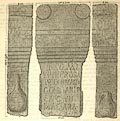 click to enlarge
click to enlargeG842E01.jpg
"Hartburn, Morpeth."
"MR. URBAN,"
"YOU will, I am sure, be glad to hear, that a Roman Altar has been lately found at OLENACUM, or Old Carlisle, concerning which I am enabled to send you an interesting Letter, and correct drawings, forwarded to me by the Rev. William Matthews, of Wigton Hall, proprietor of this celebrated station, and a Magistrate of the county of Cumberland. The only observation I would make is, that, on another consideration, he may find the puzzling lines on the first and second line were intended for FVLG.; for altars to "Juppiter Optimus Maximus Fulgerator" are far from uncommon, and even under the names of "Fulminator, Fulgurator, Tonans." On his emendations on the altars printed by Camden, and in Horsley, and noticed under Olenacum, numbers 6 and 12, in my last volume on Northumberland, I am very much indebted for his critical care and observations; and respecting his inquiry about a second edition on the Roman Antiquities I have published in that volume, I am happy to mention to himself and other Antiquarian scholars, that a very few copies of the whole of it may be obtained under the title of "THE ROMAN WALL and SOUTH TINDALE.""
"Yours, &c."
"JOHN HODGSON."
"Wigton Hall, Aug. 5."
"DEAR SIR,"
"I SEND you a drawing of an Altar which was found a few weeks ago in the bed of a small stream, which runs into the Wiza, a little to the south of the Roman Station at Old Carlisle. The letters upon it are very perfect, with the exception of those in the last line, which are injured to the extent shown in the drawing. I am unable to explain the abbreviation VLK; but the numeral VII expresses, I think, the number of times that Gordian was saluted Augustus, or Imperator, which terms, after the reign of Octavius, be-"
placename:- Olenacum
item:- inscription, roman; roman inscription; roman altar
 goto source
goto sourceGentleman's Magazine 1847 part 1 p.594 "..."
"Before we conclude we may take notice of another altar found at Olenacum, or Old Carlisle, discovered since Mr. Hodgson wrote, and recently communicated by Mr. John Rooke, of Akehead, near Wigton, through Mr. Saull, to the British Archaeological Association. It bears the following inscription,"
"DEAE BEL
LONAE RUF
INUS PRAE
EQ. ALAE AUG
ET LAINIA
NUS FIL"
"On this occasion it was remarked by Mr. C. Roach Smith, that this inscription is the only one yet found in this island dedicated to Bellona, although we learn from one of the old Roman historians, that there was a temple of Bellona at York."
placename:- Olenacum
item:- inscription, roman; roman inscription; roman altar
 goto source
goto sourceGentleman's Magazine 1851 part 2 p.507 "... Old Carlisle, about two miles from Wigton. It is supposed to be the Roman Olenacum, but the confirmation of inscriptions is wanted to support this appropriation. Among the remains from this station which are preserved by Miss Matthews of Wigton, we noticed an altar dedicated to Jupiter and Vulcan, for the health of the emperor Gordian, which appears to me to be unpublished; and the following curious specimen of orthography:- TANCORIX MULLIER VIGSIT ANNOS SEGSAGINAT:- "Tancorix, a woman; she lived sixty yers (sic)." The memorial is also remarkable for the mode adopted to express the sex of Tancorix, a British or Gaulish name, which from its termination would have been considered masculine."
placename:- Maglona
placename:- Maglove
placename:- Maglone
This is NOT Olenacum.
placename:- Olenacum
placename:- Old Carlisle
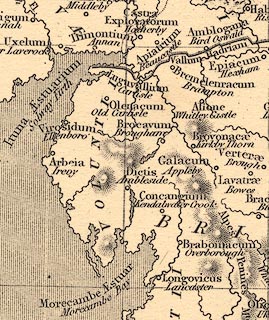 click to enlarge
click to enlargeHOR1Cm.jpg
"Olenacum / Old Carlisle"
item:- JandMN : 429
Image © see bottom of page
